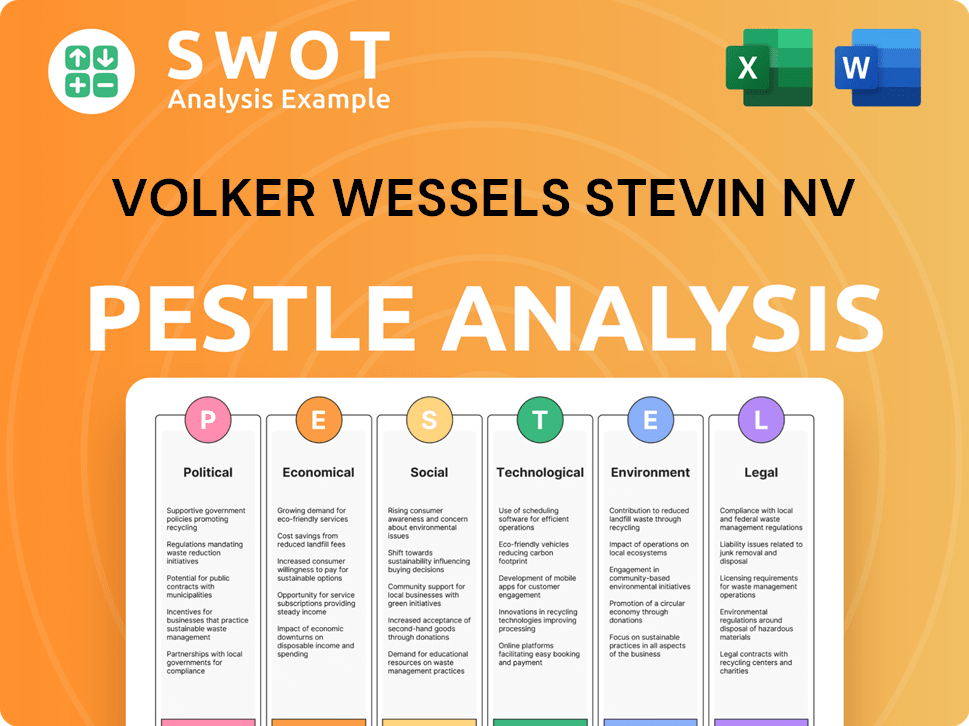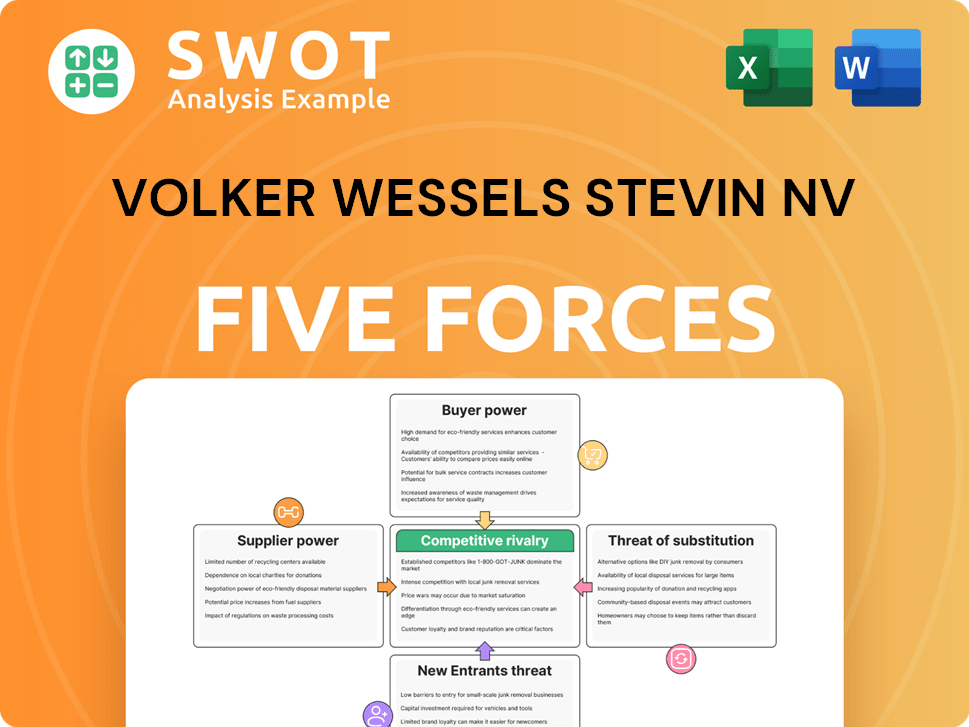Volker Wessels Stevin NV Bundle
Who Really Owns VolkerWessels Stevin NV?
The ownership structure of VolkerWessels Stevin NV is a critical aspect often overlooked, yet it fundamentally shapes the company's strategic direction and financial health. Understanding "Who owns Stevin NV" is essential for anyone seeking to assess its long-term viability and investment potential. This leading Dutch construction company, with a rich history dating back to 1854, has evolved significantly, making its current ownership a complex but fascinating topic.

This exploration into Volker Wessels Stevin NV SWOT Analysis will uncover the intricate details of Stevin NV ownership, from its origins to its present-day structure. We'll examine the key players influencing the company's trajectory, providing valuable insights for stakeholders interested in the construction company ownership. Discover the answers to questions like "Who is the owner of VolkerWessels Stevin NV" and "Is Stevin NV part of VolkerWessels group" to gain a comprehensive understanding of this industry giant.
Who Founded Volker Wessels Stevin NV?
The story of VolkerWessels Stevin NV begins in 1854 with the establishment of A. Volker Civil Engineering Company by Adriaan Volker. This marked the inception of what would become a significant player in the construction industry. Initially, the company operated as a private entity, entirely under the control of the Volker family.
Adriaan Volker, a pioneer in Dutch hydraulic engineering, laid the groundwork for the company's early success. The company's initial structure was simple, with ownership and decision-making firmly within the Volker family. The evolution from a family-owned business to a larger construction conglomerate is a key part of understanding the company's history.
The details of the equity split or shareholding percentages among family members during the company's early years are not publicly available due to its private nature. However, it's well understood that the Volker family maintained control and ownership for many decades. This family-led approach guided the company's initial growth and diversification into various civil engineering projects.
The company's early ownership was exclusively within the Volker family.
Growth was primarily self-funded or financed by the family.
Early agreements were internal family arrangements, not subject to public disclosure.
The founding family's vision focused on building critical infrastructure.
Any early ownership disputes were resolved privately within the family.
There are no public records of angel investors or external backers acquiring stakes at the beginning.
Understanding the early ownership structure of VolkerWessels is crucial for comprehending its evolution. The initial phase was characterized by family control and self-funding, setting the stage for the company's growth. Today, to find out more about the Stevin NV ownership, you can read an article about it.
- The Dutch construction company began as a private, family-owned enterprise.
- Stevin NV ownership was exclusively within the Volker family in the early stages.
- There were no external investors or public shareholders during the initial period.
- Early agreements were private, with no public documentation available.
Volker Wessels Stevin NV SWOT Analysis
- Complete SWOT Breakdown
- Fully Customizable
- Editable in Excel & Word
- Professional Formatting
- Investor-Ready Format

How Has Volker Wessels Stevin NV’s Ownership Changed Over Time?
The ownership structure of VolkerWessels Stevin NV, a prominent Dutch construction company, has seen significant changes since its inception. A key event was the 1997 merger of Koninklijke Volker Stevin NV and Kondor Wessels, creating the current entity and broadening its ownership base. Initially, the company was listed on Euronext Amsterdam, making it a publicly traded entity.
A major shift occurred in 2017 when the Wessels family, through their investment vehicle Reggeborgh, acquired full ownership of VolkerWessels, leading to its delisting and privatization. This move made the Wessels family the sole major shareholder, consolidating control. As of early 2025, Reggeborgh maintains dominant ownership of VolkerWessels. This privatization allowed for a more focused, long-term strategy, free from the immediate pressures of public markets. The consolidated ownership by Reggeborgh significantly impacts the company's strategy and governance, enabling swift decision-making and potentially more agile responses to market conditions.
| Event | Date | Impact |
|---|---|---|
| Merger of Koninklijke Volker Stevin NV and Kondor Wessels | 1997 | Formation of VolkerWessels Stevin NV; diversified ownership. |
| Initial Public Offering (IPO) | Post-1997 | Public listing on Euronext Amsterdam. |
| Delisting and Privatization | 2017 | Wessels family, through Reggeborgh, acquires full ownership; company goes private. |
The shift to private ownership by the Wessels family, through Reggeborgh, has given VolkerWessels Stevin NV greater strategic flexibility. For more insights into the company's operations, you can read about the Revenue Streams & Business Model of Volker Wessels Stevin NV.
The Wessels family, through Reggeborgh, currently holds complete ownership of VolkerWessels Stevin NV.
- Privatization in 2017 consolidated control.
- The company is no longer subject to public market pressures.
- Reggeborgh's ownership enables focused long-term strategies.
- This structure allows for quicker decision-making.
Volker Wessels Stevin NV PESTLE Analysis
- Covers All 6 PESTLE Categories
- No Research Needed – Save Hours of Work
- Built by Experts, Trusted by Consultants
- Instant Download, Ready to Use
- 100% Editable, Fully Customizable

Who Sits on Volker Wessels Stevin NV’s Board?
Since becoming a privately held entity in 2017, the composition of the Board of Directors at VolkerWessels Stevin NV is heavily influenced by its primary owner, Reggeborgh. While specific details about all board members and their connections to major shareholders or independent positions aren't publicly available as they would be for a public company, it's understood that the Wessels family, through Reggeborgh, significantly shapes board appointments. Key individuals from Reggeborgh typically hold positions on the supervisory board, ensuring the owner's strategic goals are met. The focus remains on aligning the board's direction with the long-term vision set by the controlling shareholder, reflecting the company's private structure.
The structure of a private company like VolkerWessels is straightforward regarding voting rights. The main shareholder, Reggeborgh, holds nearly all the voting power. This means there are no complex arrangements like dual-class shares or special voting rights, as control is concentrated within the Wessels family. This setup avoids the proxy battles or activist investor campaigns often seen in publicly traded companies. Decision-making is streamlined, reflecting the directives and long-term objectives set by its controlling shareholder, Reggeborgh. This structure allows for a unified strategic approach, with governance directly influenced by the company's beneficial owner. The ownership structure ensures that the strategic direction is primarily determined by Reggeborgh, streamlining decision-making processes.
| Aspect | Details | Relevance |
|---|---|---|
| Ownership | Private, controlled by Reggeborgh (Wessels family) | Direct impact on board appointments and strategic direction. |
| Board Influence | Key figures from Reggeborgh are represented on the supervisory board. | Ensures alignment with the owner's strategic vision. |
| Voting Power | Reggeborgh holds virtually all voting power. | Streamlines decision-making and strategic implementation. |
The ownership structure of VolkerWessels Stevin NV is centered around Reggeborgh, which is the primary shareholder. This private ownership model simplifies governance and decision-making processes. The Wessels family's influence ensures strategic alignment and long-term stability.
- Private ownership by Reggeborgh streamlines governance.
- The Wessels family directs strategic planning.
- Board appointments reflect owner's vision.
- Voting power is concentrated, ensuring unified direction.
Volker Wessels Stevin NV Business Model Canvas
- Complete 9-Block Business Model Canvas
- Effortlessly Communicate Your Business Strategy
- Investor-Ready BMC Format
- 100% Editable and Customizable
- Clear and Structured Layout

What Recent Changes Have Shaped Volker Wessels Stevin NV’s Ownership Landscape?
In the past three to five years, the ownership structure of VolkerWessels Stevin NV has remained consistent, primarily due to its private ownership by Reggeborgh. Since the delisting in 2017, there have been no significant public reports of share buybacks, secondary offerings, or major ownership changes. The focus for the company, under Reggeborgh's ownership, has been on operational performance and strategic acquisitions.
The construction sector shows trends of increased institutional ownership in publicly traded companies and ongoing consolidation through mergers and acquisitions. For VolkerWessels, the stable ownership structure supports long-term investment in projects and innovation without the pressures of quarterly reporting. There have been no public statements about future ownership changes or potential re-privatization or public listing. The current ownership appears to be a long-term strategy, emphasizing sustained growth and operational efficiency.
| Aspect | Details | Recent Data |
|---|---|---|
| Ownership Structure | Private | Owned by Reggeborgh |
| Delisting Year | 2017 | No public offerings since |
| Focus | Operational Performance | Strategic acquisitions and organic growth |
The Dutch construction company, VolkerWessels, maintains a steady ownership profile. The company's strategic direction remains focused on long-term growth and operational excellence, supported by its private ownership structure. This allows for investments in innovation and projects without the short-term pressures often associated with public markets.
The ownership of Stevin NV has been stable in recent years. There have been no major shifts in ownership. This stability supports long-term strategic planning and investment.
The construction industry is seeing increased institutional ownership. There is a trend towards consolidation through mergers and acquisitions. VolkerWessels aligns with this through strategic acquisitions.
There are no public announcements about future ownership changes. The current strategy emphasizes long-term growth. The focus is on operational efficiency.
The stable ownership structure of VolkerWessels Stevin NV supports sustained growth. This allows for a focus on long-term projects. The company benefits from reduced pressure from public markets.
Volker Wessels Stevin NV Porter's Five Forces Analysis
- Covers All 5 Competitive Forces in Detail
- Structured for Consultants, Students, and Founders
- 100% Editable in Microsoft Word & Excel
- Instant Digital Download – Use Immediately
- Compatible with Mac & PC – Fully Unlocked

Related Blogs
- What are Mission Vision & Core Values of Volker Wessels Stevin NV Company?
- What is Competitive Landscape of Volker Wessels Stevin NV Company?
- What is Growth Strategy and Future Prospects of Volker Wessels Stevin NV Company?
- How Does Volker Wessels Stevin NV Company Work?
- What is Sales and Marketing Strategy of Volker Wessels Stevin NV Company?
- What is Brief History of Volker Wessels Stevin NV Company?
- What is Customer Demographics and Target Market of Volker Wessels Stevin NV Company?
Disclaimer
All information, articles, and product details provided on this website are for general informational and educational purposes only. We do not claim any ownership over, nor do we intend to infringe upon, any trademarks, copyrights, logos, brand names, or other intellectual property mentioned or depicted on this site. Such intellectual property remains the property of its respective owners, and any references here are made solely for identification or informational purposes, without implying any affiliation, endorsement, or partnership.
We make no representations or warranties, express or implied, regarding the accuracy, completeness, or suitability of any content or products presented. Nothing on this website should be construed as legal, tax, investment, financial, medical, or other professional advice. In addition, no part of this site—including articles or product references—constitutes a solicitation, recommendation, endorsement, advertisement, or offer to buy or sell any securities, franchises, or other financial instruments, particularly in jurisdictions where such activity would be unlawful.
All content is of a general nature and may not address the specific circumstances of any individual or entity. It is not a substitute for professional advice or services. Any actions you take based on the information provided here are strictly at your own risk. You accept full responsibility for any decisions or outcomes arising from your use of this website and agree to release us from any liability in connection with your use of, or reliance upon, the content or products found herein.